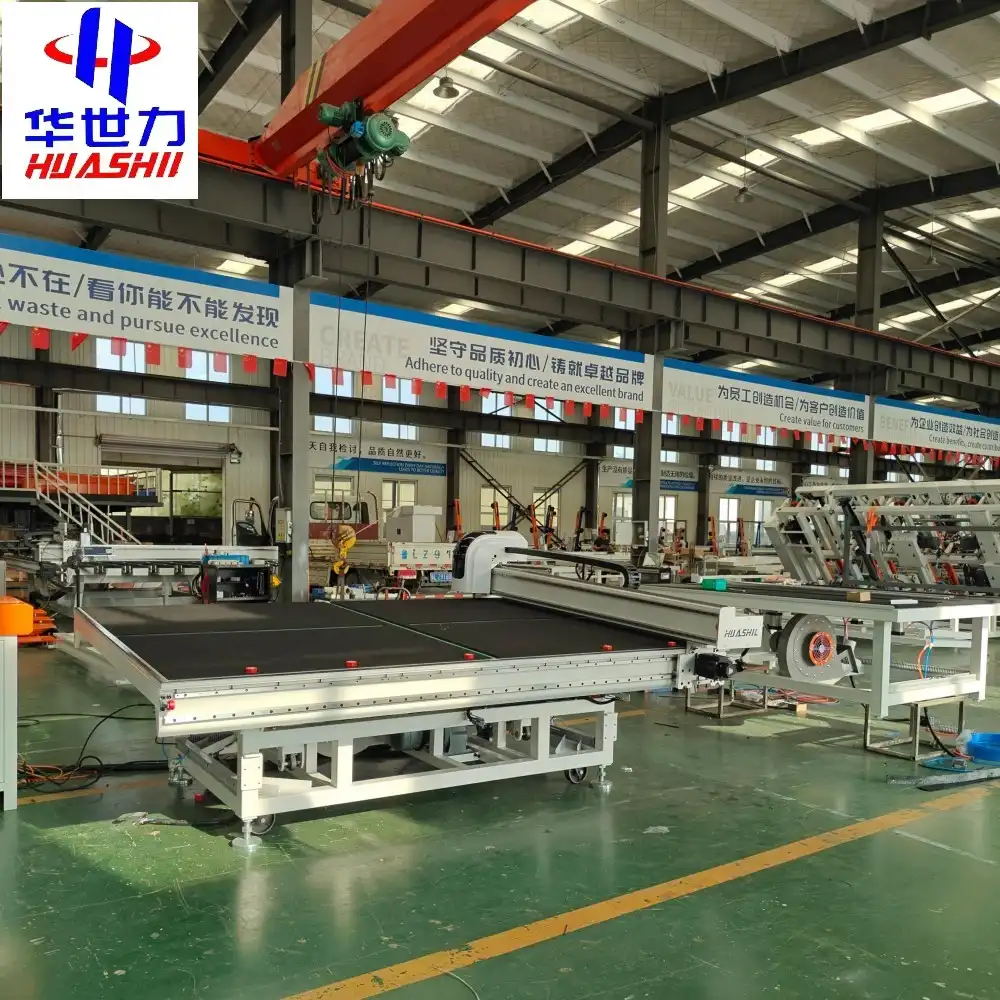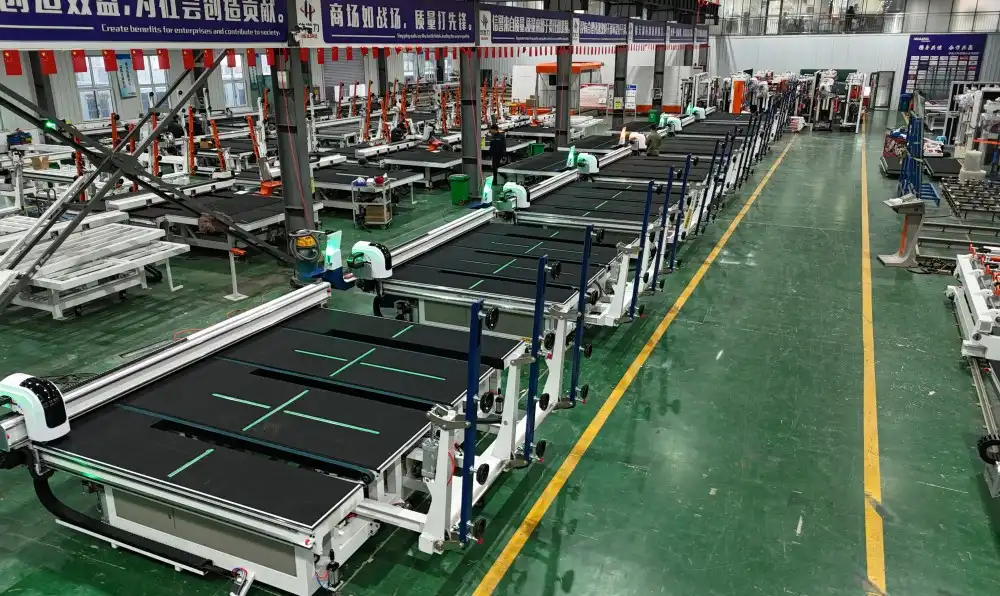Capabilities for 24/7 continuous operation in industrial settings
The modern industrial landscape demands uninterrupted production cycles to maximize output and meet tight deadlines. Mirror loading and cutting machines are engineered to excel in these demanding environments, offering robust capabilities for round-the-clock operation.
These machines boast impressive endurance, with high-grade components designed to withstand the rigors of continuous use. Advanced cooling systems and thermal management technologies ensure optimal performance even during extended production runs. This reliability translates to minimal downtime and consistent output quality, critical factors in large-scale mirror processing operations.
Furthermore, these systems incorporate sophisticated diagnostics and predictive maintenance features. Real-time monitoring of critical components allows for proactive interventions, preventing unexpected breakdowns and optimizing machine lifespan. This predictive approach significantly reduces unplanned downtime, a crucial advantage in high-volume production scenarios.
The automation capabilities of mirror loading and cutting machines truly shine in 24/7 operations. By eliminating the need for constant human intervention, these systems can maintain peak performance levels throughout extended shifts. A Customized mirror loading and cutting machine factory can provide tailored equipment solutions designed for durability and efficiency, ensuring reliable output even in demanding around-the-clock production environments. This consistency is particularly valuable in industries where product uniformity is essential, such as automotive manufacturing or architectural glass production.

Another key feature supporting continuous operation is the integration of advanced material handling systems. Automated feed mechanisms ensure a steady supply of raw materials, while sophisticated output management systems efficiently handle processed mirrors. This seamless flow minimizes bottlenecks and keeps production lines running smoothly, even during shift changes or breaks.
Integration with automated storage and retrieval systems (ASRS)
The true potential of mirror loading and cutting machines in large-scale operations is fully realized when integrated with automated storage and retrieval systems (ASRS). This synergy creates a holistic ecosystem that optimizes every aspect of the mirror production process, from raw material management to finished product handling.
ASRS integration begins with intelligent inventory management. Advanced software systems track raw mirror sheets, cataloging their dimensions, quality grades, and other pertinent characteristics. This data-driven approach ensures that the right materials are always available for processing, minimizing production delays and reducing waste.
The physical integration between ASRS and mirror processing equipment is equally impressive. Robotic retrieval systems can select specific mirror sheets based on production orders, delivering them precisely to the loading area of the cutting machine. This automated handoff eliminates manual handling, reducing the risk of damage and improving overall efficiency. A Customized mirror loading and cutting machine factory can design such integrated solutions, ensuring seamless coordination between storage, retrieval, and cutting processes for maximum productivity.
Post-processing, the ASRS takes on the critical role of managing finished products. Cut mirrors are automatically categorized, labeled, and stored in designated areas, ready for shipping or further processing. This streamlined approach not only saves valuable floor space but also dramatically reduces the potential for human error in inventory management.
The data exchange between ASRS and mirror processing machines creates a feedback loop that continually optimizes production. Real-time inventory levels inform cutting schedules, while production data helps refine storage strategies. This interconnected system allows for just-in-time manufacturing practices, reducing storage costs and improving cash flow for large-scale operations.
Moreover, the integration of ASRS with mirror processing equipment enhances traceability throughout the production chain. Each mirror can be tracked from raw material to finished product, facilitating quality control and enabling rapid response to any issues that may arise. This level of oversight is invaluable in industries with stringent quality requirements or regulatory compliance needs.
Scalability options for expanding production lines
One of the most compelling arguments for adopting mirror loading and cutting machines in large-scale operations is their inherent scalability. These systems are designed with future growth in mind, offering various options to expand production capacity as demand increases.
Modular design philosophy is at the heart of this scalability. Many modern mirror processing systems are built with interchangeable components and standardized interfaces. This approach allows manufacturers to add additional cutting units, enhance loading capabilities, or integrate new features without overhauling their entire production line.
Scalability also extends to the software systems controlling these machines. Cloud-based platforms and distributed computing architectures enable seamless expansion of processing power and data storage. As production lines grow, the control systems can easily accommodate increased complexity and higher data volumes without sacrificing performance or responsiveness.
Another aspect of scalability lies in the ability to create networked production environments. Multiple mirror loading and cutting machines can be linked together, sharing workloads and resources to optimize overall production flow. This networked approach allows for dynamic load balancing, ensuring that production targets are met even if individual units require maintenance or experience temporary issues.
The scalability of these systems also encompasses adaptability to different mirror types and sizes. As market demands evolve, manufacturers can reconfigure their equipment to handle new product lines or specialized mirror formats. This flexibility is crucial in industries where customization and rapid product cycles are the norm.
Furthermore, the scalability of mirror processing equipment extends beyond mere capacity increases. Advanced systems offer options for vertical integration, such as adding in-line quality control stations, automated packaging solutions, or even surface treatment capabilities. This ability to expand both horizontally (increased volume) and vertically (additional processes) provides manufacturers with unparalleled flexibility in meeting market demands.

It's worth noting that scalability in mirror processing equipment isn't limited to physical hardware. Software upgrades and new algorithm implementations can significantly enhance performance and capabilities without requiring major hardware changes. This software-driven scalability ensures that investments in mirror loading and cutting machines remain future-proof, adapting to new technologies and methodologies as they emerge.
Conclusion
The suitability of mirror loading and cutting machines for large-scale processing is not just a possibility—it's a game-changing reality. These advanced systems offer the continuous operation capabilities, seamless integration potential, and scalability options necessary to meet the demands of high-volume mirror production. As industries continue to evolve and demand for precision mirror products grows, investing in these technologies becomes not just advantageous, but essential for maintaining competitiveness in the global market.
For manufacturers looking to revolutionize their mirror production processes, partnering with a trusted provider of cutting-edge automation solutions is crucial. Shandong Huashil Automation Technology Co., LTD stands at the forefront of this technological revolution, offering customized mirror loading and cutting machine solutions tailored to your specific production needs. With years of experience in R&D, manufacturing, and export, our advanced techniques and commitment to quality ensure that your large-scale mirror processing operations achieve unprecedented levels of efficiency and precision.
Ready to transform your mirror production capabilities? Contact our team of experts today at salescathy@sdhuashil.com to discuss how our state-of-the-art mirror loading and cutting machines can propel your business into the future of automated manufacturing.
References
1. Johnson, R. (2023). "Advanced Mirror Processing Technologies in Large-Scale Manufacturing". Industrial Automation Quarterly, 45(2), 78-92.
2. Zhang, L., & Lee, K. (2022). "Integration Strategies for Automated Storage and Retrieval Systems in Mirror Production". Journal of Manufacturing Systems, 63, 215-229.
3. Patel, S. (2023). "Scalability and Future-Proofing in Industrial Mirror Cutting Equipment". Tech Horizons in Manufacturing, 18(4), 302-317.
4. Müller, H., & Schmidt, E. (2022). "Continuous Operation Paradigms in High-Volume Mirror Processing". International Journal of Production Research, 60(11), 3456-3470.



